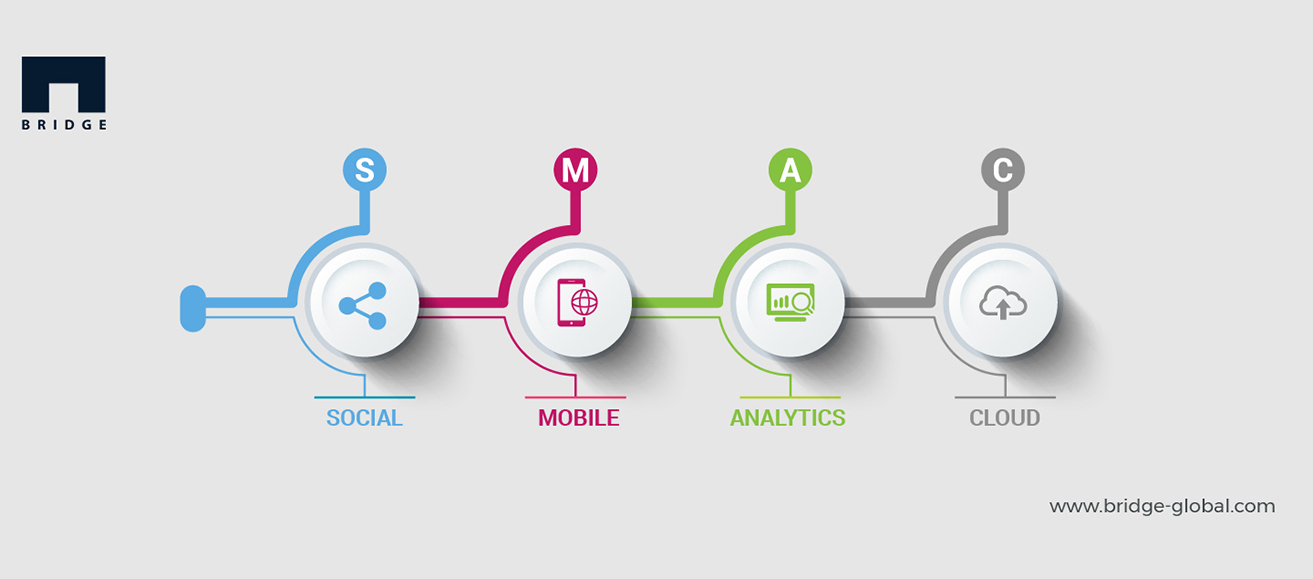Why Is SMAC The New Game-Changer?
If you want to enhance your operations in a customer-centric way with minimal overhead and maximum reach, you cannot ignore SMAC – the most trending acronym in the digital world.
What Is SMAC?
SMAC stands for Social, Mobile, Analytics, and Cloud. In other words, SMAC indicates a converged stack of these technologies. The world’s leading research and advisory firm Gartner calls it the ‘Nexus of Forces’.
The four elements of SMAC are undoubtedly the most effective pillars of successful marketing. They may not yield the desired results when they are deployed in a detached manner. But, when functioning in an integrated manner, these technological forces help enterprises to:
• foster client relationships
• improve marketing insights
• enhance operations
• get the essential competitive advantage
• drive business innovation
• streamline B2B and B2C digital strategy
The synergy of these four factors is becoming an upcoming business model in many organizations. The new SMAC business model is believed to give revolutionary business results. It makes enterprises more collaborative, productive, and connected while getting real-time data.
Let’s move on to explore the four pillars of SMAC.
1. Social Media
Social Media is no longer just a fancy phenomenon. It has become an essential tool for communication, connectivity, and social interaction. Social Media platforms deeply influence consumer decisions and performances. People depend on them for guidance regarding what to buy, where to shop, and even which firms to work with.
In order to leverage people’s growing dependence on these platforms, businesses have started using social media as one of their predominant marketing tools. They do customer engagement and brand building more effectively through these channels. Sponsored Social Media Posts are examples of these kinds of marketing practices. They help to create brand loyalty through brand-sponsored content. Facebook, Twitter, and LinkedIn allow businesses to hyper-target their key audience.
All these interactions and collaborations leave a rich pile of strong digital data across social media. These data throw valuable information about who you are, your dealings, associations, tastes and preferences. Businesses can process and utilize these data to serve their patrons with hyper-personalized services.
2. Mobile
Mobile penetration is a fact that no one can overlook. Mobile devices are amazing pieces of gadgets that are packed with a multitude of apps and sensors ranging from Accelerometer, Gyroscope, Magnetometer, GPS, barometers, proximity and motion sensors, ambient light sensors, cameras, etc.
All these not only lead to a satisfying and pleasing customer experience but also create a huge source of raw data. All information and transactions are readily available on our mobile devices and are updated on the go. This type of greater accessibility to information boosts our efficiency and productivity.
Sellers (of both products and services) and buyers are deeply connected with the invisible bond of mobile devices. Customers not only do purchases through their devices but also do pre-buying research, comparisons, review analysis, etc. Just as in social media, all these leave a massive pile of data, which can be of significant use for businesses in enhancing their operations. Today’s mobile app development focuses on creating apps that can sync, collect and analyze data about users and their networks.
3. Analytics
As the Internet of Things (IoT) is growing leaps and bounds, the amount of data generated is massive. Analytics deals with the processing of all the raw data available from various sources. It makes sense of the collected data.
Analytic tools help companies to draw insights from information and help in Decision Management and Predictive Analytics. It helps them to discover what’s working and what’s not. The valuable insights drawn from data analysis will help companies in enhancing customer engagement with their brand. It also helps in formulating new policies and strategies.
4. Cloud
Cloud Computing is a cost-effective way to store and access data without maintaining a physical server. Cloud has created an effective IT ecology and infrastructure by removing geographical barriers in storing and accessing massive amounts of information.
Storing files in the cloud not only frees up storage in our hardware and devices, but also boosts collaboration, communication and creativity. Cloud goes beyond data storage and sharing. It covers sharing of the platform, infrastructure, and services over the internet. All these help businesses to scale up fast.
A Great Case of SMAC-Enabled Operation
SMAC-enabled enterprises/organizations can stay competitive in today’s drastically changing environment.
The leading media services provider Netflix is a great example of SMAC implementation. When a user streams media from the Netflix cloud to their iPad, television, tablet, or phone, they are asked to sign in to it with their FB social login. Users are provided with multiple options to give social feedback, after viewing the show. Customer data is stored in the cloud. With advanced analytics and elaborate algorithms, Netflix’s recommendation engine suggests films tailored to the users’ tastes and preferences.
Conclusion
The unified business model in which Social, Mobile, Analytics, and Cloud technologies play an integrated role will help businesses in diverse ways. It will help in delivering products and services in an engaging, intuitive, and contextual manner cost-effectively anytime and anywhere. Optimally integrating the four wings of SMAC will position your brand successfully as you are able to take new business directions in favour of your customers. Overall, it helps in improving the IT architecture of businesses.
Want to be a Part of the SMAC Revolution?
It is a sure fact that the future is SMAC. Top businesses are focusing on embracing and improving their SMAC. We are ready to help you build your social, mobile, analytics, and cloud solutions.



